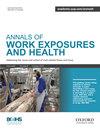381c - The Physical Activity Health Paradox: Is physical activity at work health enhancing?
IF 1.8
4区 医学
Q3 PUBLIC, ENVIRONMENTAL & OCCUPATIONAL HEALTH
引用次数: 0
Abstract
Emerging evidence has suggested a ‘Physical Activity Health Paradox’ where occupational physical activity may be harmful for cardiovascular health which is in contrast to the health enhancing effects of physical activity during leisure time. Such a paradox would have significant implications for physical activity recommendations, surveillance, research, and workplace health promotion practices, especially for workers accumulating high amounts of physical activity at work. This talk will deliver the state of the science on the physical activity health paradox, highlight existing research gaps, and discuss implications for future research and practice. Specific discussion will include an overview of the foundational epidemiological evidence suggesting paradoxical cardiovascular health risks from occupational physical activity as well as discuss hypotheses and supporting empirical evidence on explanatory physiological mechanisms. The talk will conclude by highlighting the implications on workplace health practice, research, surveillance, and guidelines.381c - 体育锻炼与健康的悖论:工作中的体育锻炼能增进健康吗?
新出现的证据表明了一种 "体力活动健康悖论",即职业体力活动可能对心血管健康有害,这与业余体力活动对健康的促进作用形成了鲜明对比。这种悖论将对体力活动建议、监测、研究和工作场所健康促进实践产生重大影响,尤其是对在工作中积累大量体力活动的工人而言。本讲座将介绍体育锻炼与健康悖论的科学现状,强调现有的研究差距,并讨论对未来研究和实践的影响。具体讨论将包括对流行病学基础证据的概述,这些证据表明职业体力活动会给心血管健康带来悖论性风险,同时还将讨论有关解释性生理机制的假设和支持性经验证据。最后,讲座将强调对工作场所健康实践、研究、监测和指南的影响。
本文章由计算机程序翻译,如有差异,请以英文原文为准。
求助全文
约1分钟内获得全文
求助全文
来源期刊

Annals Of Work Exposures and Health
Medicine-Public Health, Environmental and Occupational Health
CiteScore
4.60
自引率
19.20%
发文量
79
期刊介绍:
About the Journal
Annals of Work Exposures and Health is dedicated to presenting advances in exposure science supporting the recognition, quantification, and control of exposures at work, and epidemiological studies on their effects on human health and well-being. A key question we apply to submission is, "Is this paper going to help readers better understand, quantify, and control conditions at work that adversely or positively affect health and well-being?"
We are interested in high quality scientific research addressing:
the quantification of work exposures, including chemical, biological, physical, biomechanical, and psychosocial, and the elements of work organization giving rise to such exposures;
the relationship between these exposures and the acute and chronic health consequences for those exposed and their families and communities;
populations at special risk of work-related exposures including women, under-represented minorities, immigrants, and other vulnerable groups such as temporary, contingent and informal sector workers;
the effectiveness of interventions addressing exposure and risk including production technologies, work process engineering, and personal protective systems;
policies and management approaches to reduce risk and improve health and well-being among workers, their families or communities;
methodologies and mechanisms that underlie the quantification and/or control of exposure and risk.
There is heavy pressure on space in the journal, and the above interests mean that we do not usually publish papers that simply report local conditions without generalizable results. We are also unlikely to publish reports on human health and well-being without information on the work exposure characteristics giving rise to the effects. We particularly welcome contributions from scientists based in, or addressing conditions in, developing economies that fall within the above scope.
 求助内容:
求助内容: 应助结果提醒方式:
应助结果提醒方式:


